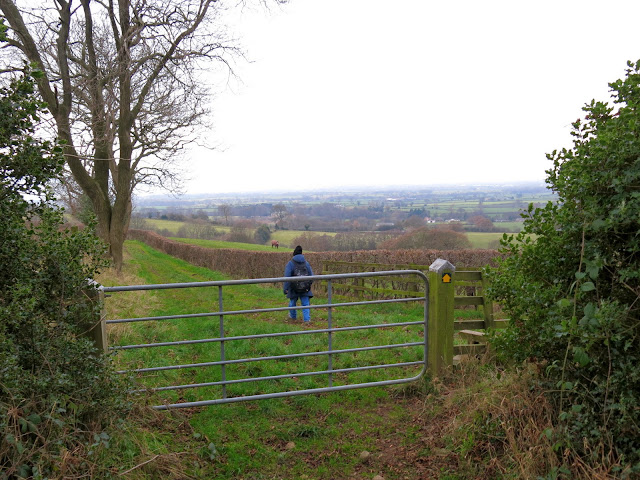Captain Cook Country from Great Ayton
8 miles Cold and Clear
We parked in the High Street at Great Ayton, opposite Petch the Butcher, who had a magnificent and tempting display of pork pies in his window.
 |
| Today's walk from The Walker's Guide to the Cleveland Hills |
 |
| Great Ayton |
We walked down the High Street and crossed the River Leven at the iron bridge opposite Suggits Cafe. Our track now followed the river along field paths towards Little Ayton, crossing the road via stiles at Cross Lane before returning to the river bank. Before Cross Lane we were surprised to see a field of deer, obviously being farmed, behind a high wire fence.
We arrived at Woodhouse Farm and continued along the river to Low Easby where we swung left across a bridge to join a lane which we followed over the Whitby to Middlesbrough Railway line to Borough Green Farm.
 |
| Hunting weather vane at Low Easby |
 |
| Clive checks new railway lines outside Low Easby |
This farm has a gateway on the left which leads into a green lane that goes straight uphill to Easby Moor. On reaching the gateway a solitary walker, a small elderly chap, met us from the opposite direction. We exchanged greetings and agreed with him that it was a blessing to wake up on a morning and find yourself still alive. "I'm 84 and still walk, but take my time," he told us proudly.
 |
| 84 years old and still hiking |
|
 |
| Looking back from green lane |
 |
| Nearly at the top |
We congratulated him on his good fortune and then began a long climb up to Easby Moor, turning to wave as he shouted "Merry Christmas" after us. At the top we turned right after passing through the moor gate. Our path now leveled out and we traversed the hillside before entering Mill Bank Wood. Walking through the wood the remains of an old bleach mill can still be seen to the right of the descent from Easby Moor. Tom Scott Burns tells us in The Walker's Guide to the Cleveland Hills that this mill was destroyed on 21st July 1840, when heavy rains above Kildale caused an enormous volume of water to burst two large fishponds at Kildale Hall creating a flood 40' high, which carried away everything in its path, including the mill, as it rushed towards Great Ayton.
 |
| Moor Gate |
 |
| Mill Bank Wood |
 |
| Kildale Church |
We emerged from the woods at Bankside Farm buildings and started to walk uphill, but decided to stop at an old barn where level stones made a good resting place for our break. We sat enjoying our coffee and scones while looking down towards Kildale Church and watching the farm's Jack Russell terrier as it slowly, very slowly, approached us, sitting down to stare at us intently every few yards. When it eventually drew closer it was easily won over by Clive's Rich Tea biscuits.
 |
| Bankside Farm |
 |
| The watcher |
 |
| View from our coffee stop |
We continued to walk uphill from the farm until we came to a fork, where we swung left through a forestry plantation that had been roughly stripped of its trees leaving a desolate area that looked like the Somme. Suddenly Captain Cook's Monument appeared on the skyline before us and we walked up to read the inscription before continuing straight on along the top of Easby Moor. The inscription tells us that the monument's foundation stone was laid in 1827, in memory of Marton and Great Ayton's famous mariner.
 |
| Easby Moor, not The Somme |
 |
| Captain Cook's Monument |
 |
| Plaque on monument |
Our track led us off the moor and eventually down a steep descent through Ayton Bank Woods, which we remembered as being very treacherous when wet from the last time we came this way . Dry today and an easy descent to the road that led us up Airey Holme Lane to Airey Holme Farm, where Captain Cook's father was employed as a bailiff in 1736.
 |
| Leaving the monument |
 |
| Looking back |
 |
| Descending from Easby Moor |
The farm is attractive with a nice duck pond and Roseberry Topping can be seen in the distance behind it. Passing by the farm, the lane leads to Airey Holme Cottage where we turned sharp left down a field track past the old quarry where whinstone was mined, apparently the only example of volcanic rock to be found on the North Yorkshire Moors.
 |
| Add caption |
 |
| Duck pond at Airey Holme Farm |
 |
Airey Holme Farm
|
 |
| Cliff Rigg Whinstone Quarry |
 |
| Remains of old winch near Cliff Rigg Quarry |
Our path then followed fields which skirt the imposing building of Cleveland Lodge and eventually returned us to Great Ayton and our car.
 |
| Muddy path alongside Cleveland Lodge |
 |
| We glimpse Cleveland Lodge through the trees |
